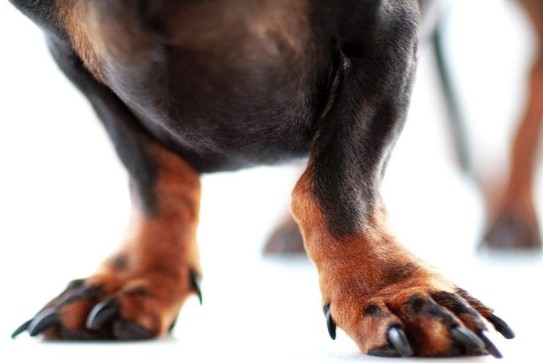How to Trim Dog Nails That Are Overgrown

Photo by Erda Estremera on Unsplash
Dogs, together with their distant cousins, the coyotes, jackals, and wolves, belong to the genus Canis. However, unlike their undomesticated distant cousins who live in the wild, dogs live in our homes. The wolves, jackals, and coyotes wander through the forests and run across rough terrains throughout their lives. On the other hand, our cute dogs run on
well-paved sidewalks, sleep on sofas, and play in well-maintained turfs.
Yes, our beautiful pets have it easy, but that means that their nails don’t get sanded down naturally. Running on rough terrains, climbing hills, and excessive digging helps sand down their distant cousins’ claws. But since that is not the case with household dogs, every dog owner must trim their pet’s nails before they become too long.
Why Are Long Nails a Problem?
It can be quite easy for you to forget to cut your pet’s nails, especially if your dog hates having the nails trimmed. But it would be best if you had a trimming timetable for your dog since overgrown nails can cause health issues and discomfort. When the nails are too long, they can cause some pain every time they touch the ground. Overgrown nails tend to push back onto the nail-bed, which causes the dog’s toes to twist sideways or puts pressure on the joints of the toes. Over time the long nails can result in tendon injuries or even cause deformed feet.
Long nails can force your dog to change his body posture. Instead of his normal pose, he will start leaning forward over his front legs as if he wants to climb a hill. Unfortunately, this will force him to adjust the hind legs, leaving the paws pulled together. The awkward posture will result in some muscles and joints being overused, which can cause health issues as he gets older. Plus, when a little pressure on the feet is painful to the dog, he will cause a commotion every time you want to lift his paw and cut the nails.
When Are the Dog’s Nails Too Long?
If the pup stands with his front legs under his shoulders, his nails shouldn’t touch the floor. If they do, then they are too long. If his nails twist sideways or if you hear them clicking when he is running around the house, then they are too long and must be trimmed.
Unfortunately, even if your pet is in pain, you can’t just chop his long nails off. There is a collection of blood vessels and nerves commonly known as ‘’quick’’ at the center of the nail. And as his nails grow, so does the quick. Trimming the overgrown nails of your dog can be quite difficult, especially since they have longer quick. So you must be very careful not to cut the nerves and blood vessels on his nails. However, if you trim the tips of the nail regularly, you can encourage his quick to recede. With that in mind, here are the steps to follow when trimming overgrown nails.
How to Trim Overgrown Dog Nails?
Make Your Dog Comfortable
If he hates having his nails cut, then the first step should be to help him overcome the fear of all the nail-trimming tools. Just like all desensitization training, this step can take some time. Pet Fashion Week recommends to start by bringing out the appropriate dog nail clipper and letting him investigate them. As he sniffs the clipper, you can reward him with a treat and praises. Please do this for a few sessions until he is comfortable or associates the trimming tools with a good thing.
If you want to use a rotary nail grinder to trim his nails, then you should follow the above procedure and introduce him to your grinder. Remember, some nail grinders can be quite noisy; therefore, work on increasing his tolerance to the tool’s noise. You can start by rewarding the dog every time you turn the grinder on! But you have to be very patient since some dogs learn faster than others. This step could take a very long time if your dog had a horrible experience with the trimming tools in the past. Eventually, your dog will learn to associate trimming devices with treats, and then you can trim his nails.
Get in the Nail Cutting Position
Before you even start trimming your dog’s nails, make sure he is comfortable and relaxed. It really helps to have another person there with you to distract, pet, and hold your dog. If your dog has a small body, you can hold him on your lap and pet him until he relaxes. But make sure you have a great view of the dog’s nails if you are holding him in your lap.
Once he is comfortable and you are in a safe position, you can lift one of the dog’s paws. And hold it next to his body to stop him from pulling his paw away. If his paws are in pain because of walking with the overgrown nails for a few days, then you should be careful. Finally, you can give his paw a light squeeze and then separate the nail you want to work on by lifting it from underneath.
Locate the Quick
Before you take the grinder or clipper to the dog’s overgrown nail, make sure you know where the nail’s quick is situated. To locate the quick, you must look at the nails in the lights. On a light-colored nail, the quick will appear as a dark, pinkish part of the nail.
Estimating where the quick starts in dogs with dark nails can be quite challenging. So, since you will be looking for the quick, you can start by cutting tiny bits of the dark nails at a time. After every cut, look at the tip of the dog’s nails. As you cut further, you will notice a grayish-pink oval appearing on the cut surface. In some dog breeds, you can see a black spot at the center of the trimmed surface. When you see this spot, you should stop cutting since you are getting closer to the quick.
Grind or Trim the Nails Quickly
Once you have gotten in the cutting position, and located the quick, you can start cutting the nails using your preferred trimming tool. Cut small bits of the nails at a time. Make sure you trim at a slight angle across the nail’s tip and follow the nail’s shape.
Cut the nails in a safe and quick motion, but remember to relax when doing this. If you become too nervous, the dog will notice and pull the paw away from you, which can be quite dangerous. To avoid accidents, make sure you remain calm while you are trimming his nails. Cut the nails efficiently and take breaks in between cuts. You can give the dog a lot of treats and praises as you continue trimming the nails to continue building confidence.
Repeat This Process Regularly

Photo by Taylor Kopel on Unsplash
Repeat this procedure for all his nails. However, if it’s your first time trimming a dog’s nails, do not be in a hurry since you won’t cut all the nails at once. Trimming overgrown dog nails is a long process that requires you to help the dog generate a positive association with nail cutting. So you might end up waiting for a few minutes between nails. And be prepared with the first aid kit, just in case one of his nails starts to bleed after you have accidentally cut the quick.
After Trimming Rewards
Trimming is a long process that requires both of you to be calm, so don’t forget to give him a treat after you have finished trimming the nails. By doing so, the dog will learn to associate this procedure with something good, and this will increase his confidence in the future.
What to Do If the Nail Bleeds
There is a possibility of something going wrong during this procedure, even if you are experienced and very cautious when trimming his nails. Cutting the quick can be very painful to the dog, so instead of panicking when this happens, you should try and stop the bleeding using styptic powder. And give a lot of treats and praises to help him stay calm. To avoid infections, make sure you prevent dirt from getting into the wound. If the bleeding doesn’t cease within 30 minutes, contact the veterinary. Once everything is under control, you can take a break from trimming for a while or stop for the day.
Set a Timetable for Cutting the Dog’s Nails
Most people overlook trimming their pet’s nails since they assume that it can be sand down naturally when they are running, but that is not the case. So once you have finished the above procedure, you should plan to deal with the nails at least once every week until a proper length is attained. Remember, the more you trim the nail’s tips, the more the quick recedes, and after a few sessions, your dog’s nails will be back to normal. After that, you can trim the nails at least once a month, but this depends on the dog breed.

